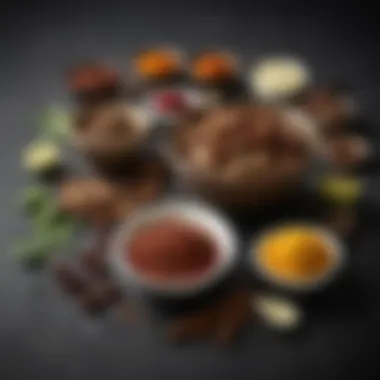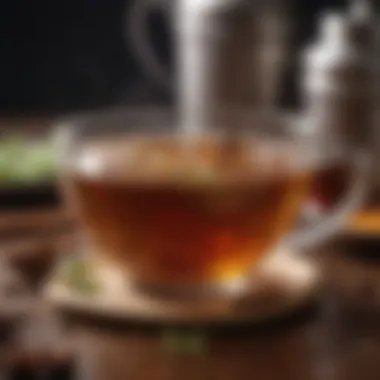Exploring the Rich Tradition of Indian Spice Tea


Intro
In the vibrant tapestry of Indian culture, few beverages hold as esteemed a position as spice tea, or chai, as it's commonly known. Steeping in history, this aromatic brew has transcended time and geopgraphy, becoming more than just a drink—it is a ritual, a conversation starter, and a comforting hug in a cup for many. Across the subcontinent, tea is not merely consumed but celebrated, with each region bringing its own flair to the preparation and enjoyment of this beloved beverage.
The roots of Indian spice tea can be traced back centuries, where it was initially prepared for medicinal uses before evolving into a social staple. The blending of tea with an assortment of spices reflects not just a love for flavors but also an understanding of natural remedies that indigenous knowledge systems have preserved through ages. Cloves, cardamom, ginger, and black pepper are just a few of the aromatic spices that might dance together in a pot, each contributing its unique flair, further enhancing the taste and potential health benefits.
Whether served on a bustling street corner, accompanied by crunchy biscuits, or as a soothing end to a long day, Indian spice tea creates a sense of connection and warmth. This article endeavors to explore this intriguing beverage, delving into its origins, preparation methods, and cultural significance. Throughout, we will highlight traditional recipes and modern interpretations that keep the legacy vibrant even in contemporary kitchens. Hence, get ready to brew your next perfect cup
"Tea is to the body as music is to the soul." - Earlene Grey
As we venture further into the depths of Indian spice tea, let us begin with an alluring overview of the recipe that embodies this rich tradition.
Preface to Indian Spice Tea
When the fragrance of spices mingles with the aroma of freshly brewed tea, it tells a story as rich and diverse as India itself. Indian spice tea, often known as masala chai, transcends mere beverage; it embodies cultural heritage, tradition, and the essence of daily life. In this article, we embark on an exploration of this harmonious blend of tea and spices, tracing its roots, understanding its ingredients, and appreciating its significance in Indian society.
Tea isn't just a drink in India; it's a ritual, a moment of pause amidst life's hustle. The importance of understanding Indian spice tea lies in its role as a cultural cornerstone. It connects people, whether sipping it at home, in bustling roadside stalls, or lavish ceremonial gatherings. It's in those little moments where friendships flourish over cups of steaming chai, that its true value begins to emerge.
The history of tea in India is as layered as the spices that flavor it. Learning about its origins allows us to appreciate how the complex interplay of geography, climate, and culture has shaped the distinct varieties we see today. Indian spice tea stands as a testament to a timeline brimming with trade, colonization, and sociocultural evolution.
Moreover, this article serves as an invitation for food lovers to delve deeper into the world of spice tea. Not only will we uncover the ingredients that give masala chai its unique identity, but we will also explore the health benefits, brewing techniques, and regional variations that make each cup distinct. As we navigate this journey, we will find that every sip of Indian spice tea is not merely a taste of warmth but a flavor of history, community, and tradition.
"A cup of chai is not just about the tea, it's about the story it tells and the hearts it warms."
The Ingredients of Indian Spice Tea
The ingredients of Indian spice tea are a crucial aspect that brings this beloved beverage to life. Each component, from the spices to the tea leaves, plays a significant role in shaping the flavor and health benefits associated with this drink. It's important to understand how these ingredients work together, both culturally and culinarily, to create that perfect cup of tea that warms not just the body but also the soul.
Common Spices Used
Cardamom
Cardamom, often referred to as the "queen of spices," is a staple in many Indian spice tea recipes. This aromatic spice does not just offer a delightful fragrance; it also provides a gentle sweetness that complements the other flavors beautifully. Cardamom is widely recognized for its digestive properties and its ability to enhance mental clarity. Plus, it lends a creamy texture to the tea without the use of milk. One unique feature of cardamom is its versatility; it can be used in both sweet and savory dishes, making it a beloved choice for many culinary enthusiasts.
Ginger
Ginger, with its sharp, zesty flavor, adds both warmth and a kick to spice tea. This spice is not just about taste; it has potent anti-inflammatory benefits that many cherish. Unlike other spices, ginger can be used fresh or dried, giving the homebrewer flexibility in how they incorporate it into their tea. A little ginger goes a long way, and while it can be overpowering if used excessively, its health benefits, such as aiding digestion and boosting immunity, make it a frequently included ingredient.
Cinnamon
Cinnamon brings a warm, sweet flavor that pairs excellently with the earthiness of tea. It is known for its antioxidant properties, and the distinct aroma creates a comforting ambiance. In Indian cuisine, cinnamon is more than just a flavor enhancer; its unique feature is its ability to balance sweet and spicy elements harmoniously. However, it's important to use the right type of cinnamon, as there are varieties that can have stronger effects, which might not appeal to everyone. A little can go a long way in adding flavor without overwhelming the other ingredients.
Cloves
Cloves are a flavor powerhouse, often used sparingly due to their intense and slightly bitter taste. This spice is well-known for its antiseptic properties, which adds to the overall health benefits of Indian spice tea. The unique feature of cloves lies in their ability to infuse the tea with a warm, woody undertone that lingers, making each sip more profound. However, with cloves, moderation is key. Too many can overshadow the more subtle spices and alter the tea’s intended flavor profile.
Different Types of Tea Leaves
Assam Tea
Assam tea is recognized for its bold flavor and briskness. Hailing from the northeastern region of India, this type of tea features a strong, malty taste that stands well against the robust spices in Indian spice tea. Assam tea is preferred by many as a morning beverage because it contains a good amount of caffeine, providing a quick pick-me-up. However, it’s wise to be cautious with brewing time; over-brewing can lead to a bitter taste, defeating its intended invigorating purpose.
Darjeeling Tea
Often dubbed the "champagne of teas," Darjeeling tea boasts a more delicate flavor profile compared to Assam. It has floral undertones and a hint of muscatel sweetness. The key characteristic of Darjeeling tea is its unique terroir; its flavor can change with seasons. This variability adds an intriguing aspect to those who savor their tea, making it a cultured choice. Yet, some might find its subtlety slightly less satisfying when paired with strong spices, so balance is vital.
Nilgiri Tea
Coming from the hills of the Nilgiri region in southern India, Nilgiri tea is prized for its fruity notes and refreshing quality. This tea often has a lighter and more fragrant taste, making it a versatile partner for spice tea. The climatic conditions in Nilgiri bring about a smoothness that appeals to many tea lovers. However, its lighter nature can sometimes cause it to be overshadowed by the spices, thus, careful selection of spices is essential to enhance rather than overpower.


Additives and Variants
Milk
Milk is frequently added to Indian spice tea, transforming it into a creamy delight. This staple ingredient offers richness and balances the spices' heat, creating a smooth mouthfeel. Traditionally, whole milk is used, but alternatives like almond or soy milk are gaining popularity. However, it's important to consider that some might be lactose intolerant, making it crucial to offer variants without milk as well.
Sugar
Sugar is the classic sweetener in spice tea, providing necessary balance to the spices' punch. The sweetness can help elevate the flavor profile, making for a more enjoyable drink. However, it can also mask the unique flavors of the spices if used excessively. Moderation is key. Alternatively, natural sweeteners can be utilized by those looking for healthier options.
Honey
Honey is often regarded as a more natural alternative to sugar in Indian spice tea. Its floral notes add a different depth of flavor, enhancing the overall taste experience. Moreover, honey has various health benefits, including its antioxidant properties, making it appealing to health-conscious drinkers. Yet, it’s vital to remember that honey can alter the tea's texture, sometimes making it thicker, so finding the right balance is essential.
"Understanding the diverse ingredients in Indian spice tea not only enriches the brewing experience but also connects us to a culture steeped in tradition."
This intricate layering of ingredients makes Indian spice tea a rich tapestry of flavors and sensory experiences. By exploring the significance of each component, one can appreciate the art and culture surrounding this enduring beverage.
Cultural Significance of Tea in India
Tea is more than just a beverage in India; it’s steeped in cultural significance that transcends the mere act of drinking. To many, it symbolizes hospitality, comfort, and tradition. Understanding its cultural roots provides insight into daily life, values, and connections among people in Indian society.
Tea as a Daily Ritual
For countless households, starting the day without a cup of tea feels unthinkable. Making chai is often likened to a sacred ritual. Families typically prepare it around 7 a.m., combining water, milk, and spices in a pot over open flame or a gas stove. At times, simply the aroma of boiling spices and tea leaves fills the air long before any sip is taken. The process reflects time spent together, allowing families to share anecdotes as they brew.
Many people also take their mid-morning or afternoon breaks with another cup, often accompanied by snacks or biscuits. This habitual practice is not solely about taste; it engenders mindfulness amid busy schedules. The ritual becomes a pause to breathe, reflect, and bond. Just as the sun rises and sets, the daily preparation of tea anchors the day.
Social Gatherings and Hospitality
In India, offering tea to guests is an unspoken etiquette that signifies warmth and welcome. Hosts often feel compelled to present their finest teas, serving it in special cups. Whether it's a surprise visit from a neighbor or an intended gathering, a pot of tea brews in anticipation, as if it were the glue binding conversations.
This welcoming gesture stretches across cultures and regions. In rural areas, this becomes a leisurely affair, where people gather to share stories or engage in discussions, whereas in urban spaces, it might be a quick sip before diving into more formal matters.
Here’s a list of common gatherings where tea takes center stage:
- Morning catch-ups
- Evening tea with friends
- Weddings and family functions
From sipping hot masala chai to cooling down with iced variants, these social interactions are a mix of nostalgia, flavors, and connections that are specific to local traditions.
Tea during Festivals
Festivals in India are a time of joy, and tea plays a fundamental role in many of these celebrations. For instance, during Diwali, it's customary to serve guests a special blend of tea that might contain rocks sugar or saffron. The inclusion of unique spices or herbs during festive times further elevates the experience. In this context, tea isn't just a drink; it transforms into a messenger of love and inclusivity, fostering moments of sharing and togetherness.
Interestingly, the preparation of tea during these times may involve elaborate processes, reflecting the significance of the occasion. Traditional Indian festivals like Holi and Eid see families and friends gather to exchange sweets, treats, and, prominently, a steaming cup of tea. In these moments, the bond over a shared cup fosters deeper connections and good spirits.
"Tea is the magic potion that adds flavor to our lives, weaving stories and connections that last a lifetime."
Through the exploration of tea's cultural importance, it becomes evident that this beverage is not just a staple but rather a thread that entwines the fabric of Indian life, signifying connections, traditions, and values across generations.
Brewing the Perfect Cup
Brewing the perfect cup of Indian spice tea is more than just a process; it’s an art form. The essence of this tea lies in the harmony between spices, tea leaves, and the brewing technique. A well-brewed cup not only brings out the unique flavors but also serves as a bridge connecting generations and cultures. Understanding specific elements of brewing is critical, as it can make or break the experience.
Steps for Brewing Spice Tea
Selecting Ingredients
When it comes to selecting ingredients, the choice must reflect the intended flavor profile. This means you should consider spices like cardamom, ginger, or cloves, which are staples in many Indian spice tea recipes. The key characteristic of selecting ingredients is diversity; using fresh and high-quality spices enhances the overall taste of the tea.
The unique feature of this selection process is that it allows for customization. For instance, those who favor a bit of heat might lean towards extra ginger, while others may prefer a sweet touch from cardamom. However, a downside could be the variability in availability, especially when sourcing authentic spices. Ultimately, the right choices can significantly elevate the drinking experience.


Infusion Technique
Infusion technique plays a critical role in extracting flavors from both tea leaves and spices. Using a simmering method, where you slowly heat your combination of ingredients, allows for a fuller extraction of essential oils and flavors. This process can be viewed as the dance of elements—spices warming up to tea leaves, resulting in a deeply infused cup.
One of the main advantages of this technique is its ability to produce a rich, aromatic cup that resonates with the essence of Indian culture. On the other hand, care has to be taken not to over-simmer, as this can result in bitterness, potentially overshadowing the desired flavors.
Brewing Time
Brewing time is another crucial component that cannot be overlooked. Generally, a brewing time of 5 to 10 minutes is optimal to harness the flavors from the ingredients without letting them become overpowering. The key characteristic here is balance—allowing enough time to let the flavors meld harmoniously. Too short a brewing time and the tea may be weak; too long, and it can become bitter.
The unique feature of timing your brew is that it can be adjusted according to personal preference. Some may enjoy a strong, robust flavor which requires a longer steep, while others might prefer a lighter touch, opting to brew for a shorter duration. Understanding how brewing time influences flavor is essential for anyone aiming to perfect their cup.
The Role of Water Quality
Water quality is fundamental in the brewing process. It's often said that water makes up about 90% of your tea, so using clean and fresh water is paramount. Soft water generally works best for extracting flavors while hard water can lead to an undesirable taste.
Also, temperature matters; boiling water works wonders for black teas commonly used in spice tea. However, overheating can make the brew taste flat. The control of water temperature is crucial as it can affect extraction and, by extension, the overall flavor profile.
"In every cup of tea, there is a story waiting to be told; let the ingredients speak."
To summarize, mastering the art of brewing Indian spice tea requires attention to detail in each step—selecting quality ingredients, perfecting infusion techniques, controlling brewing time, and ensuring water quality. Each element contributes to the overall experience, leading to a cup that pays homage to the rich traditions and flavors endemic to India.
Health Benefits of Indian Spice Tea
The realm of Indian spice tea extends well beyond its aromatic appeal and culinary charm. It’s crucial to explore the health benefits associated with this cherished beverage. Spice tea, particularly the masala chai variation that many associate with India, is rich in beneficial compounds that can enhance overall health. This section reveals the multiple aspects of health that might attract individuals to savor a steaming cup of spice tea.
Antioxidant Properties
One of the standout features of Indian spice tea is its impressive antioxidant profile. Ingredients like black tea and various spices—especially ginger and cardamom—are packed with antioxidants that combat oxidative stress in the body.
- Black Tea: Contains polyphenols, especially catechins, known for their antioxidant effects.
- Ginger: Loaded with gingerol, which has been studied for its ability to fight cellular damage.
- Cardamom: Known as the "queen of spices," it contributes significant antioxidants that help improve cardiovascular health.
These compounds collectively promote a healthier immune system, potentially reducing the risk of chronic diseases such as cancer and heart disease. Drinking this vibrant brew regularly becomes a deliciously proactive step toward maintaining one's well-being.
Digestive Benefits
Moving into the digestive arena, Indian spice tea stands as a holistic helper. Many of its key ingredients, such as ginger and cinnamon, have been revered traditionally for their ability to aid digestion. They work wonders when it comes to promoting smoother digestive processes.
- Ginger: Often recommended for its effectiveness in alleviating nausea and improving gut health. It helps stimulate the production of digestive juices, essential for breaking down food efficiently.
- Cinnamon: Not just for flavor, this spice can help regulate blood sugar levels, which is critical for preventing common digestive issues.
When consumed, spice tea can help soothe an uneasy stomach and alleviate bloating, making it a comforting yet practical choice for those with sensitive digestive systems.
Anti-inflammatory Effects
Inflammation is a common foe linked to numerous health issues, from arthritis to heart disease. The spices used in Indian spice tea have notable anti-inflammatory properties that fight such ailments.
- Turmeric: Commonly included in some regional variations, contains curcumin, a potent anti-inflammatory compound that many studies have lauded.
- Cloves: Have eugenol, which has shown effects in reducing inflammation.
Drinking spice tea regularly can contribute to lower levels of inflammation in the body, potentially providing relief from chronic pain and supporting long-term health benefits.
"A soothing cup of Indian spice tea not only brings warmth to the soul but fortifies the body with invaluable health benefits."
Regional Variations of Spice Tea
The beauty of Indian spice tea lies not only in its traditional roots but also in the various interpretations that arise from different regions. Each locality brings its own flair, influenced by local ingredients and cultural practices. Understanding these regional variations offers a deeper appreciation for the beverage's complexity and its significance in Indian culture.
Masala Chai from the North
Masala Chai is arguably the most celebrated form of spice tea in India, particularly in the northern regions. This variant combines strong Assam tea with a medley of spices—typically cardamom, ginger, and black pepper; it’s an aromatic symphony quite pleasing to the palate. In households, there's almost a meditative ritual around its preparation. People often boast about their family recipes passed down generations, adjusting the spice levels with the same dedication as a fine winemaker.
When you visit families in places like Delhi or Punjab, you’ll almost always find masala chai being served with savory snacks during gatherings. The strong, spicy brew is the perfect warm welcome, inviting convivial conversations around the brass or clay pots where the tea simmers. Its cultural importance is also seen during festivals when families come together, and making masala chai becomes a shared affair, blending flavors and stories.


Kashmiri Chai from the North
Kashmiri Chai, on the other hand, is a delightful departure from the spiced norms. Known for its delicate pink hue and the use of green tea instead of black, it is a visual treat as much as a culinary one. The infusion of spices such as cardamom, along with crushed nuts—typically pistachios or almonds—gives it a rich texture and nutty flavor. Unlike its spicier cousins, Kashmiri chai is often enjoyed on its own, highlighting the tea's soothing qualities.
Rituals surrounding Kashmiri chai are deeply woven into the social fabric of the region. It's common to serve it during gatherings, especially in winters, accompanied by Bakarkhani, a type of pastry. Some families even add a touch of milk to enhance its creaminess, making each cup slightly different from the last. This chai embodies a sense of warmth, offering solace in the bustling life characteristic of the Kashmir valley.
South Indian Filter Coffee Tea Blend
In southern India, you find a unique blend that merges traditional tea with the region's cherished coffee culture, producing what is known as the Filter Coffee Tea Blend. This unusual mix embraces the bold taste of strong black tea combined with the rich, aromatic notes of South Indian coffee. The process starts with brewing the coffee in a traditional coffee filter and then mixing it with a robust tea infusion, often flavored with spices like cardamom or ginger.
What sets this blend apart is its indulgence in sweetness; sugar is often added liberally, and milk complements the blend, creating a comforting drink reminiscent of both chai and coffeehouse vibes. It's typical to see this ambrosial beverage enjoyed at breakfast or during afternoon breaks in households across Tamil Nadu and Karnataka. The hybridization of flavors encapsulates the eclectic nature of Indian culture, where culinary creativity knows no bounds.
"From the bustling streets of Delhi to the serene valleys of Kashmir, each cup of spice tea tells a tale—a narrative rich in culture and flavor, ready to be explored."
Through these regional variations, it's clear that Indian spice tea is more than just a drink; it's a vessel for stories, heritage, and hospitality. Each style not only showcases local ingredients but also serves as a reminder of the intricate tapestry of cultural practices that define Indian society.
Innovations and Modern Twists
In the evolving landscape of culinary arts, Indian spice tea has embraced a refreshing wave of innovations and modern interpretations. This adaptation is not merely a whim of tradition, but a reflection of the changing tastes, dietary needs, and lifestyles of today’s society. As the world moves faster and seeks convenience, the ability to innovate while respecting heritage becomes indispensable. Whether through fusion recipes or alterations suited for unique dietary preferences, these innovations allow the timeless essence of spice tea to flourish in new contexts.
Fusion Recipes
Fusion recipes represent a beautiful clash of cultures and flavors, creating dishes that both celebrate their roots and invite novelty. For instance, consider the intriguing combination of traditional masala chai with green tea. Unlike the standard black tea, green tea offers its own delicate flavor which, when paired with spices like cardamom and ginger, provides a light yet aromatic experience. Adding ingredients like lemongrass introduces a fresh twist that resonates with those who enjoy vibrant, citrus notes.
Another inventive recipe is the matcha chai latte. This stunning blend incorporates the earthiness of matcha with the spicy warmth of masala. The frothed milk adds a creaminess that contrasts beautifully with the spices murmuring in the background. This beverage not only fuels energy but also serves as a visual treat, appealing to the Instagram-savvy generation.
But fusion doesn’t stop at beverages. Spice-infused desserts like chai-spiced macarons or ice cream have started making appearances, enticing dessert lovers while keeping the traditional spices at heart. The melding of flavors creates a diverse experience that satisfies the palate’s desire for the familiar while daring it to explore new terrains.
Dietary Adaptations
With an increasing number of people being health-conscious or allergic to certain ingredients, dietary adaptations in Indian spice tea have taken a prominent role. For those avoiding caffeine, a suitable alternative could be rooibos chai. Rooibos, being caffeine-free, allows one to indulge in the rich flavor profile of chai without the jitters. Additionally, it boasts its own health benefits, including antioxidants that contribute positively to one’s well-being.
Furthermore, for those on a plant-based diet, substituting cow's milk with almond or oat milk in spice tea offers a creamy texture without straying from ethical choices. Nut milks add an interesting flavor dimension while remaining aligned with modern dietary preferences.
The craft of sweetening is also evolving. Instead of refined sugars, many are turning to natural sweeteners like stevia or agave. These alternatives cater to those who are mindful of their sugar intake, allowing everyone to enjoy Indian spice tea without compromising their health goals or diet.
Overall, the innovations and adaptations related to Indian spice tea not only respect its historical roots but also ensure its relevance in contemporary society. The continued exploration and experimentation with spice tea prepare it to face the future passionately while soaking in the age-old heritage of Indian culture.
"Tea is a religion of the art of life." - Okakura Kakuzō
As food culture continues to morph, the Indian spice tea tradition celebrates its adaptability, ensuring that it remains an essential part of life's tapestry.
Culmination: The Timelessness of Indian Spice Tea
The tradition of Indian spice tea represents not just a beverage choice but a link between generations, cultural practices, and the natural world. It is remarkable how something so simple as a cup of tea can weave together history and personal narratives. Embracing the timelessness of this drink speaks volumes about the values it embodies: comfort, connection, and heritage.
Reflecting on Cultural Heritage
At its core, Indian spice tea is steeped in cultural significance. From the bustling street corners where chaiwalas serve steaming cups to families coming together over a pot of masala chai, these moments create a deep sense of belonging. The traditional practices tied to making and sharing this drink are as diverse as the spices used in its preparation.
This beverage has also become symbolic in various cultural rituals— weddings, festivals, or simple evenings at home. For instance, in many Indian households, the morning ritual of brewing chai serves as a gentle invitation to the day, offering a sense of routine that is both grounding and soothing. It invites people to pause, connect, and reflect, a moment that seems ever more necessary in today’s fast-paced world.
Furthermore, with its roots entrenched in ancient traditions, every sip of this concoction tells a story. The use of spices like cardamom, ginger, and cinnamon connects herbal wisdom with culinary artistry. Indeed, each region in India boasts its own unique twist on spice tea, showcasing the country’s vast and rich tapestry of cultural influences.
Embracing Spice Tea in Modern Life
In the contemporary setting, the ways of enjoying Indian spice tea have evolved yet again. As lifestyles shift and people seek both flavor and health benefits, this traditional brew has found its place in modern diets. The health benefits of spices have been recognized widely, making spice tea a go-to choice for health enthusiasts.
Moreover, with the rise of social media, recipes and innovative twists on traditional chai have made their rounds, appealing to younger audiences. Alternate versions such as vegan chai or iced chai are slowly carving out a niche, while still retaining the essence of what makes spice tea beloved.
Not just a drink anymore, spice tea has become a culinary canvas where creativity thrives. New blends, international infusions, and dietary adaptations offer a fresh perspective on a classic staple, ensuring its relevance into the future.
As we navigate through life, embracing the traditions of spice tea certainly nurtures our connection to both our roots and our modern identity, reminding us that while times change, the love for a comforting cup never fades.
"In each cup of Indian spice tea lies a universe—of flavors, history, and culture, waiting to be savored."
Ultimately, the timelessness of Indian spice tea isn’t merely in its recipe but in its ability to connect people across time and space, making it a cherished companion for generations to come.















